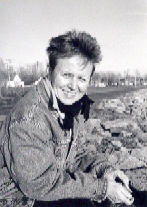 Lyne Bastien was born in the Abitibi region of Quebec in 1957. She has participated in a number of exhibitions: "Les Femmeuses," Pratt and Whitney Canada, (2002 & 2003), Longueuil; the "Exchange Show," Temple University, Tyler School of Art, (2002) Philadelphia, USA; "Les 200 Ans de la Lithographie," National Library of Quebec, (1998) Montreal; "Les Abitibians en Exil," Rouyn-Noranda Centre, (1994) Rouyn; "Multi Media," Visual Arts Centre, (1992) Montréal; "La Guilde Graphique: 25 years of Contemporary Prints," (1989) Montreal.
Lyne Bastien was born in the Abitibi region of Quebec in 1957. She has participated in a number of exhibitions: "Les Femmeuses," Pratt and Whitney Canada, (2002 & 2003), Longueuil; the "Exchange Show," Temple University, Tyler School of Art, (2002) Philadelphia, USA; "Les 200 Ans de la Lithographie," National Library of Quebec, (1998) Montreal; "Les Abitibians en Exil," Rouyn-Noranda Centre, (1994) Rouyn; "Multi Media," Visual Arts Centre, (1992) Montréal; "La Guilde Graphique: 25 years of Contemporary Prints," (1989) Montreal.
Her works have been acquired by Concordia University, the Cirque de Soleil, the Confédération des Caisses Populaires, the National Library of Quebec, the BNP Paribas Bank, the Art Academy of Cracovia, Poland, among others.
* * * * * * * * * *
"What
the paper attracts exists, only it has never been seen
before. . . the paper captures in an instant a whole teeming
world of facts and accidents which really exists, although
the human eye is incapable of seeing it."
- Jean Dubuffet, Empreintes, 1957
Laudes II, monotype, 100 x 74 cm, 2003
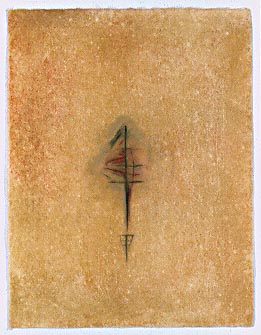 |
The art of
Lyne Bastien illuminates what Dubuffet perceived years ago: that
there are qualities inherent in paper that make it ideal for certain
forms of art.
Lyne Bastien
states that paper and printmaking were part of the media she wished
to explore in art school. She was encouraged by the American Robert
Biguelow, (the printer for Motherwell), who served as her academic
as well as spiritual guide. The teacher advised his student to
put all her tools (technical skills) away in a suitcase to allow
herself more freedom to exercise her imagination. Seeing the current
production one has to conclude this was very good advice. Maturity
and experience have taught her to select only those technical
elements that facilitate "what it is that she wants to say
and not how."
During her career, Bastien has experimented with different techniques
in the creation of works on paper such as lithography and etching.
Today, her preferred method is the monotype. The monotype is associated
with printmaking in that involves the use of print media -- plates,
inks, press -- but does not require a matrix, which offers the
possibility of multiples. Thus, the monotype is considered a 'painterly'
process because the image is painted or drawn directly onto the
flat surface -- either metal or plexiglass -- with inks that are
then transferred directly onto the paper through the etching press.
The result is a unique piece, hence the prefix 'mono'. Lyne Bastien
adds to the originality of her pieces by enhancing them with color
pencil and crayon often.
Odyssée I, monotype, 46 x 64 cm, 1989
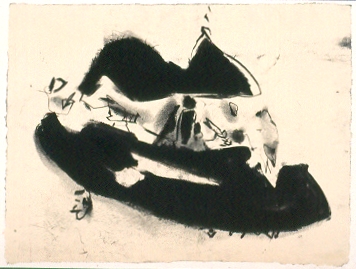 |
|
Mana, monotype, 43 x 57 cm, 1990
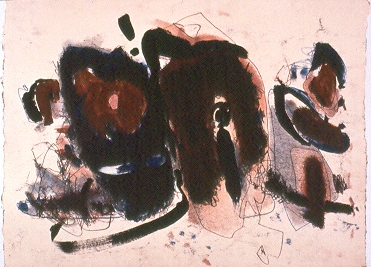 |
|
Bastien states
that at the beginning she used the monotype as a way of producing
ideas rapidly. In time, she realized that this method offered
a wide range of possibilities for expression. The qualities that
attract Bastien to monotype are the speed and immediacy of the
method. The fact that it is so close to painting also had great
appeal; it gave the artist "a natural avenue to the spontaneity,
intuition and crudeness" she sought. In addition to all that,
there is the added benefit of the accessibility in printmaking
that allows a more dynamic exchange between artist and public.
The ritual
of the preparation - the selection of the most appropriate support
for a specific project from an array of beautiful hand made rag
papers, the measuring and tearing of the paper, the mixing and
modifying of the inks and the setting of the press -- puts the
artistic mind in gear and gives ideas the chance to take shape.
Bastien observes: "the physical process of making prints
is now an integral part of my creative process." According
to the artist, her studio is her favourite place in the world,
a place of retreat where she is embraced by a sense of intimacy,
a place where she thrives in her work as well as a place that
permits her to reflect on every aspect of her life.
The art of
Lyne Bastien is nourished by many different sources. Naturally,
these evolved and changed as the artist matured.The
early works of the artist remind of the art of Arshile Gorky in
the abstraction of form, the rhythmic composition, the harmonious
use of colour and the irrational aspects of the work, i.e. the
feelings they evoke and imagination they reflect.
Arshile Gorky, Water of the Flowery Mill
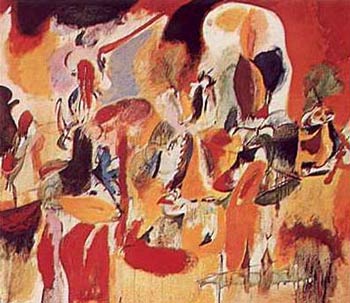 |
|
Warrior, monotype 43 x 57 cm, 1991
 |
|
Bastien states
that she comes from a strong Catholic background. The printmaker's
own Judaeo-Christian heritage plays a central role in her work
of the mid-90s. The images of these years mark a period of transition
in the work of the artist. Evidently, at this point she concentrates
on religious symbols.
Précarius, monotype, 122 x 122 cm, 1997
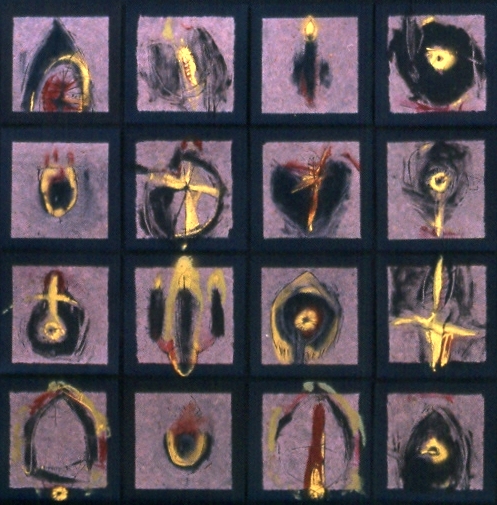 |
|
Semailles, monotype, 122 x 122 cm, 1997
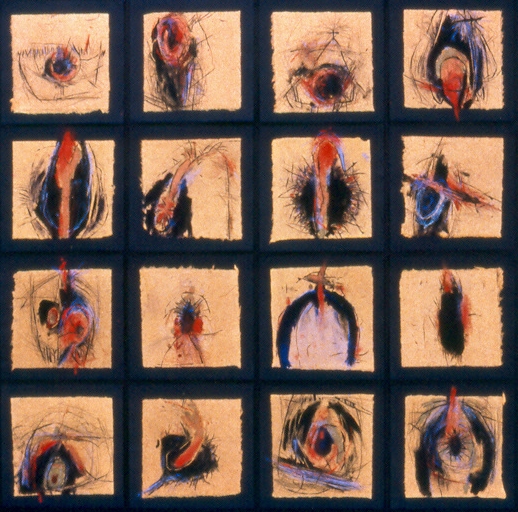 |
|
Slowly but
surely, her work shows a movement towards freedom and away from
religious iconography. Today, her heritage reveals itself only
to a certain extent in the central elements and the titles chosen
making the content of her work spiritual but by no means religious.
Observing
her production through time it is easy to see that the artist
develops rapidly, freeing her work from the formal links of the
art of Gorky and, by extension, from those of the Abstract expressionist
movement as well as from strictly cultural sources. She moves
towards a very personal style and aesthetic language remaining,
consciously or unconsciously, close to the art brut in
all its introverted subjectivity. The forms of her figures and
objects are completely devoid of modelling and have a tendency
towards the generic, the compositions blatantly disregard illusory
space and the colours, although they are mixed, are mainly warm
and vibrant. Hers is an art that comes out of a need to express
rather than to intellectualize.
Although Bastien's paternal great grand-mother was native Canadian,
the artist did not have much chance to interact with this side
of her family and learned little about this part of her heritage
while she was growing up; however, the organic character of her
work, her attraction towards the unknown, the mystical and the
spiritual denote an instinctive link to her ancestry.
Embrasement IV, monotype, 51 x 38 cm, 2003
 |
The origins
of the current production of the artist stem from her interest
in the concept of religious ecstasy and its similarity to that
of orgasmic ecstasy. In reading some descriptions of saints who
had ecstatic experiences the artist realised that they were comparable
to the orgasmic experience. From there, she became fascinated
by the parallels between a mystic communion with God and a moment
of intense communion between human beings. At this point Bastien
began to integrate the concepts of sexual experience and religion
in her work. In time, the religious aspect becomes less and less
important in her art transforming itself into a spiritual quest.
Today form and content are more linked to nature than anything
else.
Soif, monotype, 100 x 74 cm, 2003
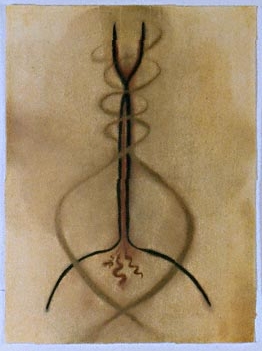 |
Overall, her
creations are very personal and primal but, nonetheless, spiritual
manifestations which distinguish themselves by their sublime harmony
and beauty. The artist places a central symbolic image amidst
a deep background which, borrowing the words of Dubuffet, create
different aspects ". . . which, in faster or slower tempo,
are assumed by the entire natural world, everywhere, the world
of mountains and shores, rocks or skins, of the depths of the
sea or sandy deserts. . . " The central symbolic image floats
in this background and whether its meaning remains obscure or
it is revealed by its form or the title of the piece, the profound
significance and the reverence inherent to it are not lost to
the beholder. In fact, the experience of being in the centre of
a room surrounded by the works of Bastien is similar to that of
standing in awe surrounded by nature or, for that matter, in a
quiet place of meditation.
A
solo exhibition of Lyne Bastien will be held at The Dorval Cultural
Center (1335 Lakeshore road, Dorval, Tel. 514-633-4000) from November
26th to December 10th, 2003. The vernissage will take place on
Wednesday November 26, 7 to 9 PM.
Editors
note: To find more about the artist or to get in touch with her,
please write to contact@artsandopinion.com
to the attention of Marissa Consiglieri de Chackal - Arts Editor.